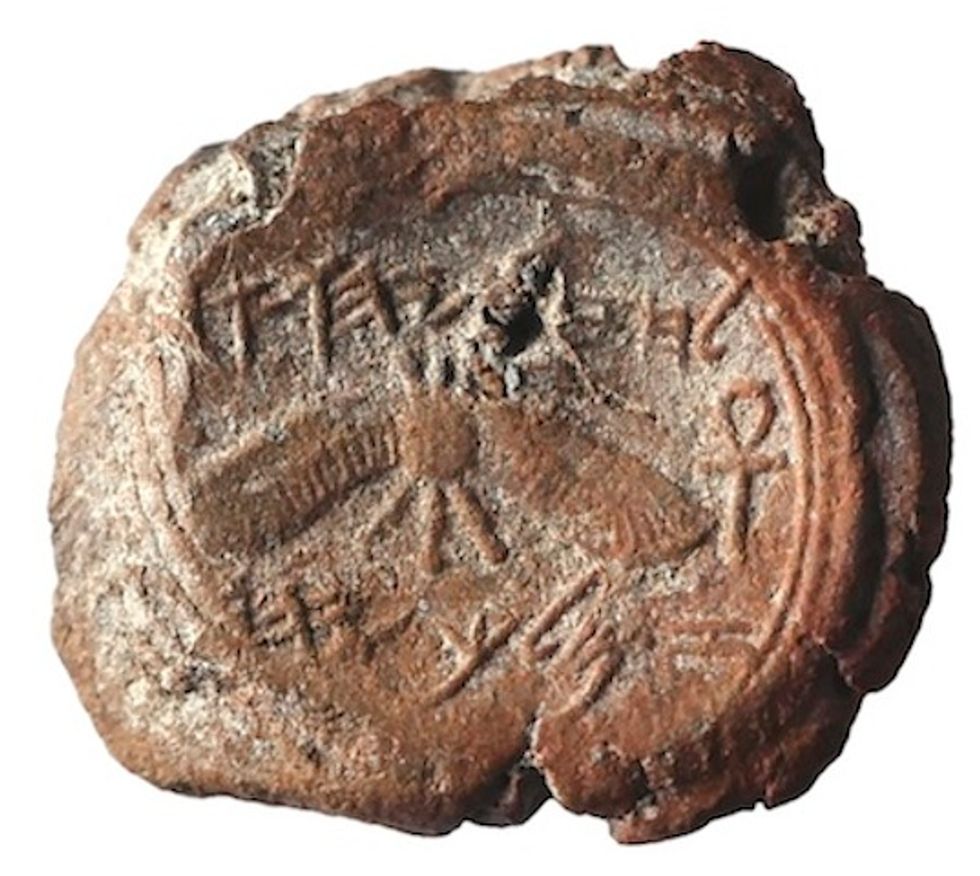
A seal impression dating to the reign of King Hezekiah was unearthed at the foot of the southern wall of the Temple Mount in Jerusalem. (Photo: Ouria Tadmor via Dr. Eilat Mazar/Hebrew University)

Israeli archaeologists announced Wednesday that they found a seal impression bearing the name of King Hezekiah, whose reign was described in the book of 2 Kings as well as elsewhere in the Bible.
After deciphering the royal seal impression found during excavations near the southern wall of the Temple Mount in Jerusalem, the researchers concluded it is “the closest as ever that we can get to something that was most likely held by King Hezekiah himself,” said Dr. Eilat Mazar of the Hebrew University’s Institute of Archaeology who directed the excavation.
The impression bears the ancient Hebrew inscription: “Belonging to Hezekiah [son of] Ahaz king of Judah” as well as a two-winged sun with downturned wings and two ankh, the looped cross symbol of life.

The Times of Israel reported that the royal seal impression was found five years ago but that archaeologists then didn’t realize its significance.
That changed when Hebrew University archaeologist Reut Ben Arieh began deciphering the inscription and noticed tiny punctuation marks separating the words “king” and “Judah.”
“Immediately we understood,” Ben Arieh told the Times of Israel.
The centimeter-wide impression was imprinted on a bulla, or inscribed clay, around which the depression of the edge of the ring that the seal was on could be seen, researchers said.
Archaeologists said the bulla sealed a papyrus document that had been rolled and tied with thin cords. Those cords left their mark on the reverse side of the bulla, suggesting the document may have been signed by the king himself, the Times of Israel noted.
“Although seal impressions bearing King Hezekiah's name have already been known from the antiquities market since the middle of the 1990s, some with a winged scarab (dung beetle) symbol and others with a winged sun, this is the first time that a seal impression of an Israelite or Judean king has ever come to light in a scientific archaeological excavation,” Mazar said in a statement announcing the discovery.
According to the biblical narrative in 2 Kings 18, Hezakiah son of Ahaz and Abijah began his reign at the age of 25 and ruled in Jerusalem for 29 years. Historians place his rule over Judah from about 715 to 686 B.C., though there are debates over the precise years.
The Bible describes Hezekiah as pious and driven by his faith in God, destroying the idols which had flourished during his father’s reign.
As is written in 2 Kings 18:5, “Hezekiah trusted in the Lord, the God of Israel. There was no one like him among all the kings of Judah, either before him or after him.”

The seal impression was among dozens found during archaeological excavations south of the Temple Mount in an area called Ophel where Mazar said artifacts previously found provide concrete evidence of the reigns of King David and King Solomon.
Researchers last year announced that they had decoded the oldest inscription ever found in Jerusalem at the same site as the Hezekiah seal.
That inscription — composed of eight letters depicting the Hebrew word for wine — was carved into a clay jar and is believed to have been written during King Solomon’s reign.
Despite the discovery announced Wednesday, along with countless other historical artifacts, the Palestinian Authority regularly accuses Israel of trying to “Judaize” Jerusalem and dismisses any Jewish historical connection to the city.
Most of the discoveries have been made in and around the Temple Mount, the holiest site in Judaism and third-holiest to Muslims after Mecca and Medina. Palestinians demand that east Jerusalem, which includes all of the major holy site, be the capital of a future independent Palestinian state.
The excavation that unearthed the seal was a joint project by the Israel Antiquities Authority and the Hebrew University of Jerusalem. The earth sifting facility where archaeologists found the seal impression is run jointly by the Israel Nature and Parks Authority and the City of David Foundation.